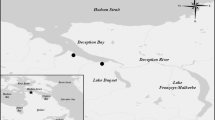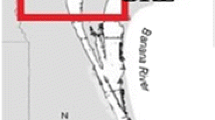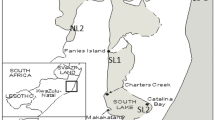Abstract
Metallothionein, cadmium, zinc, copper, and mercury concentrations were measured in adult lesser black-backed gulls, Larus fuscus; and metallothionein, cadmium, zinc, and copper concentrations were measured in fledgling Cory's shearwaters, Calonectris diomedea. In gulls, metallothionein was positively correlated with cadmium (kidney r=0.83, liver r=0.46), zinc (kidney r=0.46, liver r=0.37), and copper (kidney r=0.28, liver r=0.34). Mercury levels in lesser black-backed gulls showed no correlations with metallothionein or with any other metal. In shearwaters metallothionein was positively correlated with cadmium in the kidney (r=0.41) but not in liver, zinc in kidney (r=0.43) and liver (r=0.52), and copper in kidney (r=0.55) but not in liver. Cadmium levels were the most important factor determining tissue metallothionein concentrations in adult lesser black-backed gulls demonstrating the role of metallothionein in heavy metal detoxification. In fledgling Cory's shearwaters, the most important factor in determining metallothionein concentrations in kidney was copper concentrations, and in liver, zinc concentrations. During the latter phases of chick growth high levels of zinc are required for feather development, and at this time the binding of cadmium may be masked by the presence of a large amount of zinc- and copper-bound metallothionein. These results illustrate disparate roles of metallothionein, the levels of which will be in a state of flux both seasonally and annually.
Similar content being viewed by others
References
Blomquist S, Frank A, Petersson LR (1987) Metals in liver and kidney tissues of autumn migrating dunlin, Calidris alpina and curlew sandpiper Calidris ferruginea staging at the Baltic sea. Mar Ecol Prog Ser 35:1–13
Burger J, Pokras M, Chafel R, Gochfeld M (1994) Heavy metal concentration in feathers of common loons (Gavia immber) in the northeastern United States and age differences in mercury levels. Environ Monit Assess 30:1–7
Cosson RP (1989) Relationships between heavy metal and metallothionein-like protein levels in the liver and kidney of two birds: the greater flamingo and the little egret. Comp Biochem Physiol 94C:243–248
Cosson RP, Amiard JP, Amiard-Triquet C (1988) Trace elements in little egrets and flamingo of Carmargue, France. Ecotoxicol Environ Safe 15:107–116
Cosson RP, Amiard-Triquet C, Amiard JP (1991) Metallothionein and detoxification. Is the use of detoxification proteins for MTs a language abuse? Water Air Soil Pollut 57:555–567
Cuvin-Aralar MLA, Furness RW (1991) Mercury and selenium interaction a review. Ecotoxicol Environ Safe 21:348–364
Elliott JE, Scheuhammer AM, Leighton FA, Pearce PA (1992) Heavy metals and metallothionein concentrations in Atlantic Canadian seabirds. Arch Environ Contam Toxicol 22:63–73
Furness RW, Muirhead SJ, Woodburn M (1986) Using bird feathers to measure mercury in the environment: relationships between mercury content and moult. Mar Pollut Bull 17:27–30
Haarakangas H, Hyvärinen H, Ojanen M (1974) Seasonal variations and the effects of nesting and moulting on liver mineral content in the house sparrow Passer domesticus L. Comp Biochem Physiol 47A:153–163
Honda K, Min BY, Tatsukawa R (1986) Distribution of heavy metals and their age related changes in the eastern great white egret Egretta alba modesta, in Korea. Arch Environ Contam Toxicol 15:185–187
Hutton M (1981) Accumulation of heavy metals and selenium in three seabird species from the United Kingdom. Environ Pollut (A) 26:129–145
Karin M (1985) Metallothioneins: proteins in search of function. Cell 41:9–10
Maegden JL, Hacker CS, Schroder GD, Weir FW (1982) Accumulation of lead and cadmium in the royal tern and sandwich tern. Arch Environ Contam Toxicol 11:99–102
Martin JH, Flegal AR (1975) High copper concentrations in squid livers in association with elevated levels of silver, cadmium and zinc. Mar Biol 30:51–55
Nicholson JK (1981) The comparative distribution of zinc, cadmium, and mercury in selected tissues of the herring gull Larus argentatus. Comp Biochem Physiol 68C:91–94
Nicholson JK, Kendall MD, Osborn D (1983) Cadmium and mercury nephrotoxicity. Nature 304:633–635
Nriagu JO (1988) A silent epidemic of environmental global metal poisoning? Environ Pollut 50:139–161
Ohlendorf HM, Anderson DW, Boellstorff DE, Mulhern BM (1985) Tissue distribution of trace elements and DDE in brown pelicans. Bull Environ Contam Toxicol 35:183–192
Olafson RW (1981) Differential pulse polarographic determination of murine metallothionein induction kinetics. J Biol Chem 256:1263–1273
Onosaka S, Cherian MC (1981) The induced synthesis of metallothionein in various tissues of rats. 1. Effects of repeated injection of cadmium salts. Toxicol 14:254–253
Osborn D (1978) A naturally occurring cadmium and zinc binding protein from the liver and kidney of Fulmaris glacialis, a pelagic North Atlantic seabird. Biochem Pharmacol 27:822–824
— (1979) Seasonal changes in the fat, protein and metal content of the starling Sturnis vulgaris. Environ Pollut 19:145–155
Piotrowski JK, Trojanowska B, Wiewska-Knypl JM, Bolanowska W (1974) Mercury binding in the kidney and liver of rats repeatedly exposed to mercuric chloride: induction of metallothionein by mercury and cadmium. Toxicol Appl Pharmacol 27:11–19
Reid M, Hacker CS (1982) Spacial and temporal variation in lead and cadmium in the laughing gull, Larus atricilla. Mar Pollut Bull 13(11):387–389
Renzoni A, Focardi S, Fossi C, Leonzio C, Mayol J (1986) Comparison between concentrations of mercury and other contaminants in eggs and tissues of Cory's shearwater Calonectris diomedea, collected on Atlantic and Mediterranean islands. Environ Pollut (A) 40:17–35
Scheuhammer AM (1987) The chronic toxicity of aluminium, cadmium, mercury and lead in birds: a review. Environ Pollut 46:263–295
— (1988) The dose dependent deposition of cadmium into organs of Japanese quail following oral administration. Toxicol Appl Pharmacol 95:153–161
Scheuhammer AM, Cherian MG (1986). Quantification of metallothionein by a silver-saturation method. Toxicol Appl Pharmacol 82:417–425
Scheuhammer AM, Cherian MG (1991) Quantification of metallothionein by a silver saturation technique. Meth In Enzymology 205:78–83
Scheuhammer AM, Templeton DM (1990) Metallothionein production: similar responsiveness of avian liver and kidney to chronic cadmium administration. Toxicol 60:151–159
Sendelbach LE, Klassen CD (1988) Kidney synthesises less metallothionein than liver in response to cadmium chloride and cadmiummetallothionein. Toxicol Appl Pharmacol 92:95–102
Slemr F, Langer E (1992) Increase in global atmospheric concentrations of mercury inferred from measurements over the Atlantic ocean. Nature 355:434–436
Smith JD, Plues L, Heyraso M, Cherry RD (1984) Concentrations of the elements Ag, Al, Ca, Cd, Cu, Fe, Mg, Mn, Pb and Zn and the radionuclides 210Pb and 220Po in the digestive gland of the squid, Notodarus gouldi. Mar Environ Res 13:55–68
Stewart FM, Thompson DR, Furness RW, Harrison N (1994) Seasonal variation in heavy metal levels in tissues of common guillemots, Uria aalge, from northwestern Scotland. Arch Environ Contam Toxicol 27:168–175
Sunde ML (1972) Zinc requirements for normal feathering of commercial leghorn-type pullets. Poult Sci 51:1316–1322
Supplee WC, Combs GF, Blamley DL (1958) Zinc and potassium effects on bone formation, feathering and growth of poults. Poult Sci 37:63–67
Thompson DR (1990) Metal levels in marine vertebrates. In: Furness RW, Rainbow PS (eds) Heavy metals in the marine environment. CRC Press, Boca Raton, FL, pp 143–182
Thompson DR, Stewart FM, Furness RW (1990) Using seabirds to monitor mercury in marine environments. Mar Pollut Bull 21:339–342
Thompson DR, Furness RW, Walsh PM (1992) Historical changes in mercury concentrations in the marine ecosystem of the north and northeast Atlantic ocean as indicated by seabird feathers. J Appl Ecol 29:79–84
Walsh P (1990) The use of seabirds as monitors of heavy metals in the marine environment. In: Furness RW, Rainbow PS, (eds) Heavy metals in the marine environment. CRC Press, Boca Raton, FL, pp 183–204
Author information
Authors and Affiliations
Rights and permissions
About this article
Cite this article
Stewart, F.M., Furness, R.W. & Monteiro, L.R. Relationships between heavy metal and metallothionein concentrations in lesser black-backed gulls, Larus fuscus, and Cory's shearwater, Calonectris diomedea . Arch. Environ. Contam. Toxicol. 30, 299–305 (1996). https://doi.org/10.1007/BF00212287
Received:
Revised:
Issue Date:
DOI: https://doi.org/10.1007/BF00212287




